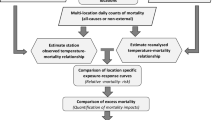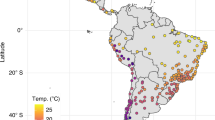Abstract
We project the change in ozone-related mortality burden attributable to changes in climate between a historical (1995–2005) and near-future (2025–2035) time period while incorporating a non-linear and synergistic effect of ozone and temperature on mortality. We simulate air quality from climate projections varying only biogenic emissions and holding anthropogenic emissions constant, thus attributing changes in ozone only to changes in climate and independent of changes in air pollutant emissions. We estimate non-linear, spatially varying, ozone–temperature risk surfaces for 94 US urban areas using observed data. Using the risk surfaces and climate projections we estimate daily mortality attributable to ozone exceeding 40 p.p.b. (moderate level) and 75 p.p.b. (US ozone NAAQS) for each time period. The average increases in city-specific median April–October ozone and temperature between time periods are 1.02 p.p.b. and 1.94 °F; however, the results varied by region. Increases in ozone because of climate change result in an increase in ozone mortality burden. Mortality attributed to ozone exceeding 40 p.p.b. increases by 7.7% (1.6–14.2%). Mortality attributed to ozone exceeding 75 p.p.b. increases by 14.2% (1.6 28.9%). The absolute increase in excess ozone mortality is larger for changes in moderate ozone levels, reflecting the larger number of days with moderate ozone levels.
This is a preview of subscription content, access via your institution
Access options
Subscribe to this journal
Receive 6 print issues and online access
$259.00 per year
only $43.17 per issue
Buy this article
- Purchase on Springer Link
- Instant access to full article PDF
Prices may be subject to local taxes which are calculated during checkout



Similar content being viewed by others
References
US EPA Integrated Science Assessment for Ozone and Related Photochemical Oxidants Integrated Science Assessment for Ozone and Related Photochemical Oxidants 2013 Available from: http://oaspub.epa.gov/eims/eimscomm.getfile?p_download_id=511347.
Jacob DJ, Winner DA . Effect of climate change on air quality. Atmos Environ 2009; 43 (1): 51–63.
Mickley LJ, Jacob DJ, Field B, Rind D . Effects of future climate change on regional air pollution episodes in the United States. Geophys Res Lett 2004; 31 (24): L24103.
Nolte CG, Gilliland AB, Hogrefe C, Mickley LJ . Linking global to regional models to assess future climate impacts on surface ozone levels in the United States. J Geophys Res 2008; 113 (D14): D14307.
Wu S, Mickley LJ, Leibensperger EM, Jacob DJ, Rind D, Streets DG . Effects of 2000–2050 global change on ozone air quality in the United States. J Geophys Res 2008; 113 (D6): D06302.
Bell ML, Peng RD, Dominici F . The exposure–response curve for ozone and risk of mortality and the adequacy of current ozone regulations. Environ Health Perspect 2006; 114 (4): 532–536.
Smith RL, Xu B, Switzer P . Reassessing the relationship between ozone and short-term mortality in U.S. urban communities. Inhal Toxicol 2009; 21 (Suppl 2): 37–61.
Wilson A, Rappold AG, Neas LM, Reich BJ . Modeling the effect of temperature on ozone-related mortality. Ann Appl Stat 2014; 8 (3): 1728–1749.
Fiore AM, Naik V, Spracklen DV, Steiner A, Unger N, Prather M et al. Global air quality and climate. Chem Soc Rev 2012; 41 (19): 6663.
Ren C, Williams GM, Mengersen K, Morawska L, Tong S . Does temperature modify short-term effects of ozone on total mortality in 60 large eastern US communities? An assessment using the NMMAPS data. Environ Int 2008; 34 (4): 451–458.
Thurston GD, Ito K . Epidemiological studies of acute ozone exposures and mortality. J Expo Anal Environ Epidemiol 2001; 11 (4): 286–294.
Jhun I, Fann N, Zanobetti A, Hubbell B . Effect modification of ozone-related mortality risks by temperature in 97 US cities. Environ Int 2014; 73: 128–134.
Samet JM, Dominici F, Zeger SL, Schwartz J, Dockery DW . The National Morbidity, Mortality, and Air Pollution Study. Part I: Methods and methodologic issues. Research report (Health Effects Institute): Cambridge, MA. 2000.
Samet JM, Zeger SL, Dominici F, Curriero FC, Coursac I, Dockery DW et al. The National Morbidity, Mortality, and Air Pollution Study. Part II: Morbidity and mortality from air pollution in the United States. Research report (Health Effects Institute): Cambridge, MA. 2000.
Bell ML, McDermott A, Zeger SL, Samet JM, Dominici F . Ozone and short-term mortality in 95 US urban communities, 1987-2000. JAMA 2004; 292 (19): 2372–2378.
Schmidt GA, Ruedy R, Hansen JE, Aleinov I, Bell N, Bauer M et al. Present-day atmospheric simulations using GISS ModelE: Comparison to in situ, satellite, and reanalysis data. J Clim 2006; 19 (2): 153–192.
Nolte CG, Otte T, Pinder R, Bowden J, Herwehe J, Faluvegi G et al. Influences of regional climate change on air quality across the continental U.S. projected from downscaling IPCC AR5 simulations In: Steyn DG, Builtjes PJH, Timmermans RMA (eds) Air Pollution Modeling and its Application XXII. Springer: Dordrecht, The Netherlands. 2014 pp 9–12.
Fann N, Nolte CG, Dolwick P, Spero TL, Brown AC, Phillips S et al. The geographic distribution and economic value of climate change-related ozone health impacts in the United States in 2030. J Air Waste Manage Assoc 2015; 65 (5): 570–580.
Skamarock WC, Klemp JB, Dudhia J, Gill DO, Barker DM, Duda MG et al. A description of the advanced research WRF version 3. Boulder, CO 2008 Available from: http://oai.dtic.mil/oai/oai?verb=getRecord&metadataPrefix=html&identifier=ADA487419.
Taylor KE, Stouffer RJ, Meehl GA . An overview of CMIP5 and the experiment design. Bull Am Meteorol Soc 2012; 93 (4): 485–498.
Byun D, Schere KL . Review of the governing equations, computational algorithms, and other components of the models-3 community multiscale air quality (CMAQ) modeling system. Appl Mech Rev 2006; 59 (2): 51.
Complete Demographic Database (CD). Woods & Poole Economics: Washington, DC. 2001.
US EPA Environmental Benefits Mapping and Analysis Program—Community Edition. US EPA: Research Triangle Park, NC. 2013.
IPCC Climate Change 2013 - The Physical Science Basis. Contribution of Working Group I to the Fifth Assessment Report of the Intergovernmental Panel on Climate Change Stocker T, Qin D, Plattner G, Tignor M, Allen S, Boschung J et al (eds) Cambridge University Press: Cambridge, United Kingdom and New York, NY, USA. 2014 p 1535.
van Vuuren DP, Edmonds J, Kainuma M, Riahi K, Thomson A, Hibbard K et al. The representative concentration pathways: an overview. Clim Change 2011; 109 (1-2): 5–31.
Knowlton K, Lynn B, Goldberg RA, Rosenzweig C, Hogrefe C, Rosenthal JK et al. Projecting heat-related mortality impacts under a changing climate in the New York City region. Am J Public Health 2007; 97 (11): 2028–2034.
Bell ML, Goldberg RA, Hogrefe C, Kinney PL, Knowlton K, Lynn B et al. Climate change, ambient ozone, and health in 50 US cities. Clim Change 2007; 82 (1-2): 61–76.
Tagaris E, Liao K-J, DeLucia AJ, Deck L, Amar P, Russell AG . Potential impact of climate change on air pollution-related human health effects. Environ Sci Technol 2009; 43 (13): 4979–4988.
Post ES, Grambsch A, Weaver C, Morefield P, Huang J, Leung L-Y et al. Variation in estimated ozone-related health impacts of climate change due to modeling choices and assumptions. Environ Health Perspect 2012; 120 (11): 1559–1564.
Simon H, Reff A, Wells B, Xing J, Frank N . Ozone trends across the United States over a period of decreasing NOx and VOC emissions. Environ Sci Technol Technol 2015; 49 (1): 186–195.
Acknowledgements
The United States Environmental Protection Agency through its Office of Research and Development funded and managed the research described here. It has been subjected to the Agency’s administrative review and approved for publication. Support for AW: this research was supported in part by NIH Grants ES007142 and R21 ES022585-01, and by an appointment to the Research Participation Program for the US Environmental Protection Agency, Office of Research and Development, administered by the Oak Ridge Institute for Science and Education through an interagency agreement between the US Department of Energy and EPA. Support for BJR: this research was supported by NIH Grants 5R01ES014843-02 and R21ES022795-01A1 and EPA Grant R835228.
Author information
Authors and Affiliations
Corresponding author
Ethics declarations
Competing interests
The authors declare no conflict of interest.
Additional information
Supplementary Information accompanies the paper on the Journal of Exposure Science and Environmental Epidemiology website
Supplementary information
Rights and permissions
About this article
Cite this article
Wilson, A., Reich, B., Nolte, C. et al. Climate change impacts on projections of excess mortality at 2030 using spatially varying ozone–temperature risk surfaces. J Expo Sci Environ Epidemiol 27, 118–124 (2017). https://doi.org/10.1038/jes.2016.14
Received:
Accepted:
Published:
Issue Date:
DOI: https://doi.org/10.1038/jes.2016.14
Keywords
This article is cited by
-
Disruption in global supply chain and socio-economic shocks: a lesson from COVID-19 for sustainable production and consumption
Operations Management Research (2022)
-
Transcriptomics of single dose and repeated carbon black and ozone inhalation co-exposure highlight progressive pulmonary mitochondrial dysfunction
Particle and Fibre Toxicology (2021)
-
Inaction on Climate Change Projected to Reduce European Life Expectancy
Population Research and Policy Review (2021)
-
Heat-related mortality at the beginning of the twenty-first century in Rio de Janeiro, Brazil
International Journal of Biometeorology (2020)
-
Health Effects of Climate Change Through Temperature and Air Pollution
Current Pollution Reports (2019)



